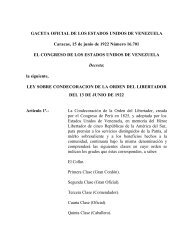Chapter 4
Chapter 4
Chapter 4
You also want an ePaper? Increase the reach of your titles
YUMPU automatically turns print PDFs into web optimized ePapers that Google loves.
Example 4.2: Infinite Plane of Charge<br />
Consider<br />
an infinitely large non-conducting plane in the xy-plane with uniform surface<br />
charge<br />
density σ . Determine the electric field everywhere in space.<br />
Solution:<br />
(1) An infinitely large plane possesses a planar symmetry.<br />
(2) Since the charge is uniformly distributed on the surface, the electric field E must<br />
point perpendicularly away from the plane,<br />
<br />
<br />
E= E kˆ.<br />
The magnitude of the electric field<br />
is constant on planes parallel to the non-conducting plane.<br />
Figure 4.2.9 Electric field for uniform plane of charge<br />
We choose our Gaussian surface to be a cylinder, which is often referred to as a “pillbox”<br />
(Figure 4.2.10). The pillbox also consists of three parts: two end-caps and , and a S<br />
curved side . S<br />
3<br />
S1 2<br />
Figure 4.2.10 A Gaussian “pillbox” for calculating the electric field due<br />
to a large plane.<br />
(3)<br />
Since the surface charge distribution on is uniform, the charge enclosed by the<br />
Gaussian “pillbox” is qenc = σ A,<br />
where A= A1 = A2<br />
is the area of the end-caps.<br />
9

















